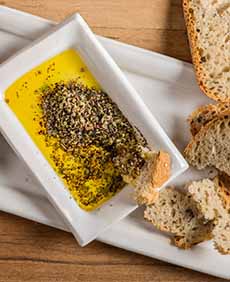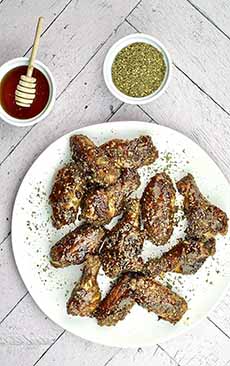Za’atar: A Staple Spice Of The Middle East & How To Use It
|
Za’atar is a flavorful spice blend used in many dishes throughout the Middle East. It’s also found its way to American fare from crusted tuna to hummus to chicken wings. The spelling is also romanized as zaatar, zahtar, za’tar, and zatar. Za’atar (ZAH-tar, American pronunciation ZAH’tar) is both a culinary herb and a spice blend. In addition to salt and the two base spices (sesame seeds, often toasted, and sumac) za’atar is a blend of savory dried herbs such as oregano or marjoram and thyme, plus toasted spices like coriander and cumin. Most Americans are not familiar with sumac. The special tanginess of sumac is the key to the best za’atar. Yes, it’s related to the poisonous shrub by the same name, but the red berries of the culinary variety are happily edible (poison sumac has white berries). The final za’atar blend is herby, nutty, salty, savory, and slightly tangy. Like other spice blends, for example curry from India, the ingredients and proportions vary from region to region. In the Middle East, za’atar is commonly eaten with pita, which is dipped in olive oil and then za’atar and is a popular breakfast item. The olive oil/za’atar mixture is also spread on a dough base and baked as a bread or flatbread. It can also be baked as a filling within the bread. The spice blend is used as a seasoning for meats and vegetables and sprinkled onto hummus and labneh. In the U.S., za’atar is more commonly sprinkled into EVOO as a bread dipper. But there are so many more uses. This dish can be ready in 15 minutes. Thanks to Sid Wainer & Sons for the recipe. For The Tuna 1. MAKE the dressing: Combine the oil, vinegar, and lemon juice in a small bowl and whisk to blend. Season with salt and pepper. Set aside. 2. PREHEAT a wide sauté pan over medium-high heat. 3. PLACE the za’atar into a shallow bowl. Gently coat the tuna with the spice blend, pressing it gently into the top and bottom of the steaks. 4. COAT the bottom of the pre-heated pan with olive oil. Place the tuna steaks into the pan and sear for two minutes on each side. 5. TRANSFER the tuna to a cutting board, and slice it into 1⁄4 in planks. Place the salad greens onto the serving plate, and top with the sliced tuna. 6. DRIZZLE with the lemon vinaigrette, and serve. Za’atar is considered in biblical scholarship to be the ezov of the Hebrew Bible, often translated as hyssop but distinct from modern Hyssopus officinalis [source]. There is evidence that the za’atar plant was known and used in Ancient Egypt, although its ancient name has not been determined with certainty. Remains of Thymbra spicata, one herb species used in modern za’atar preparations, were found in the tomb of Tutankhamun. In Jewish tradition, Saadiah (d. 942), Ibn Ezra (d. circa 1164), Maimonides (1135–1204), and Obadiah ben Abraham (1465–1515) identified the ezov mentioned in the Hebrew Bible with the Arabic word za’atar. Za’atar as a seasoning blend first dates back to the Middle Ages (12th century) in Palestine, making it one of the most ancient spice blends in both Levantine culture and in the world [source]. Once used mainly by Arab bakeries, za’atar is now a common herb blend in Israeli cuisine. Hyssopus officinalis, the leading herb in a za’atar blend, is a shrub in the Lamiaceae or mint family (basil, lavender, basil, mint, oregano, rosemary, and thyme are also members). Hyssop is native to the Middle East, Southern Europe, and the region surrounding the Caspian Sea. As a homeopathic (folk) remedy, it has been used for centuries as an antiseptic, cough reliever, and expectorant. While the plant has been cultivated in the last 50 years, wild za’atar was on the verge of extinction in Israel due to over-harvesting. In 1977, an Israeli law was passed declaring it a protected species, with violators subject to fines. If you have an herb garden, you buy seeds and grow it at home. |
|
|
|
CHECK OUT WHAT’S HAPPENING ON OUR HOME PAGE, THENIBBLE.COM.
|
||









